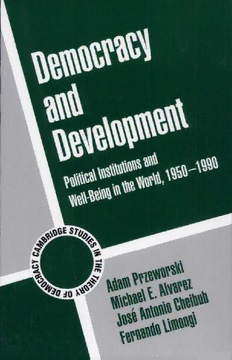
Democracy and development: political institutions and well-being in the world 1950-1990 PDF
Preview Democracy and development: political institutions and well-being in the world 1950-1990
Democracy and Development Is economic development conducive to political democracy? Does democracy foster or hinder material welfare? These two questions are examined by looking at the experiences of 135 countries between 1950 and 1990. Descriptive information, statistical analy- ses, and historical narratives are interwoven to gain an under- standing of the dynamics of political regimes and their impact on economic development and other aspects of material welfare. The findings, several of them quite surprising, dispel any notion of a trade-off between democracy and development. Economic devel- opment does not tend to generate democracies, but democracies are much more likely to survive in wealthy societies. The type of political regime has no impact on the growth of total national income, and political instability affects growth only in dictator- ships. Per capita incomes rise more rapidly in democracies because populations increase faster under dictatorships. In general, political regimes have greater effects on demography than on economics. Adam Przeworski is Carroll and Milton Petrie Professor in the Department of Politics at New York University. Michael E. Alvarez is Assistant Professor of Political Science at DePaul University. José Antonio Cheibub is Assistant Professor of Political Science at Yale University. Fernando Limongi is Associate Professor of Political Science at the University of São Paulo. CAMBRIDGE STUDIES IN THE THEORY OF DEMOCRACY General Editor ADAM PRZEWORSKI New York University OTHER BOOKS IN THE SERIES Jon Elster, ed., Deliberative Democaracy Adam Przeworski, Susan Stokes, and Bernard Manin, eds., Democracy, Accountability, and Representation Democracy and Development Political Institutions and Well-Being in the World, 1950–1990 Adam Przeworski New York University Michael E. Alvarez DePaul University José Antonio Cheibub Yale University Fernando Limongi University of São Paulo CAMBRIDGE UNIVERSITY PRESS Cambridge, New York, Melbourne, Madrid, Cape Town, Singapore, São Paulo Cambridge University Press The Edinburgh Building, Cambridge CB2 2RU, UK Published in the United States of America by Cambridge University Press, New York www.cambridge.org Information on this title: www.cambridge.org/9780521790321 © Adam Przeworski, Michael E. Alvarez, José Antonio Cheibub, and Fernando Limongi 2000 This publication is in copyright. Subject to statutory exception and to the provisions of relevant collective licensing agreements, no reproduction of any part may take place without the written permission of Cambridge University Press. First published 2000 Reprinted 2002, 2003 A catalogue record for this publication is available from the British Library ISBN13 9780521790321 hardback ISBN10 0521790328 hardback ISBN13 9780521793797 paperback ISBN 10 0 521 79379 3 paperback Transferred to digital printing 2005 Contents List of Tables and Figures page xi Acknowledgments xvii Introduction 1 Questions 1 Methods 7 Plan 10 1 Democracies and Dictatorships 13 Introduction 13 Democracy and Dictatorship 14 Operational Rules: Filling Offices by Contested Elections 18 “Botswana” and the Alternation Rule 23 Summary of Rules 28 Distinguishing among Democracies and Dictatorships 30 What We Did Not Include 33 Stability and Change of Political Regimes 36 Stability and Change of Political Leadership 51 Conclusion 54 Appendix 1.1: Alternative Approaches 55 Appendix 1.2: Classification of Political Regimes, 1950–1990 59 Appendix 1.3: Basic Data about Regime Dynamics 69 Appendix 1.4: The “Short” Data Base 77 2 Economic Development and Political Regimes 78 Introduction 78 Development and Democracy 78 Regime Dynamics 88 vii Contents Level of Economic Development and Regime Dynamics 92 Economic Growth and Regime Dynamics 106 Income Inequality 117 Economic Factors in Context 122 Democratic Institutions and the Sustainability of Democracy 128 Conclusion 136 Appendix 2.1: Dynamic Probit Model 137 Appendix 2.2: Survival Models 139 3 Political Regimes and Economic Growth 142 Introduction 142 Political Regimes and Economic Growth 146 Poor and Wealthy Countries 158 Miracles and Disasters 176 Conclusion 178 Appendix 3.1: Identification, Specification, and Robustness 179 Appendix 3.2: Estimating the Contribution of Public Investment 184 4 Political Instability and Economic Growth 187 Introduction 187 Contemporaneous Political Upheavals 189 Past Instability 193 Expectations 200 Conclusion 211 Appendix 4.1: Estimating the Impact of Expectations on Economic Performance 213 5 Political Regimes and Population 216 Total Income, Population, and Per Capita Income 216 Political Regimes and Population Growth 218 Explanations 233 Human Capital, Fertility, and Economic Growth 256 Conclusion 264 Appendix 5.1: Calculating Age Structure 265 Conclusion 269 Appendix C.1: Simulation 278 viii Contents Appendix I: Selection Model 279 Selection as a Problem of Identification 279 Statistical Models of Selection 281 Statistical Models of Performance 285 Estimating Selection-Corrected Models of Performance 287 Appendix II: Codebook 291 References 301 Author Index 313 Country Index 316 Subject Index 320 ix
